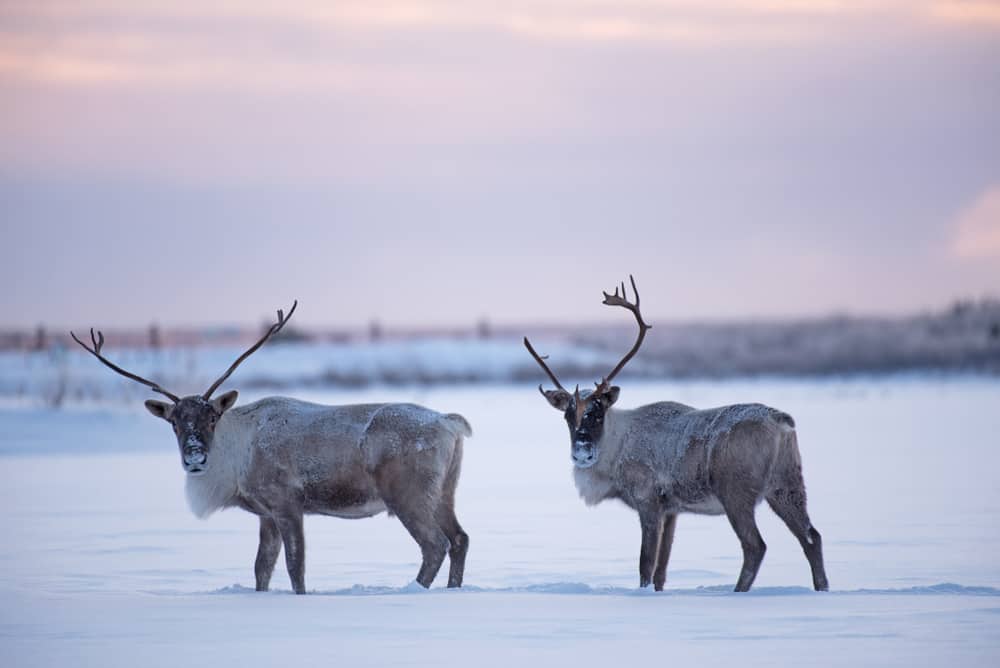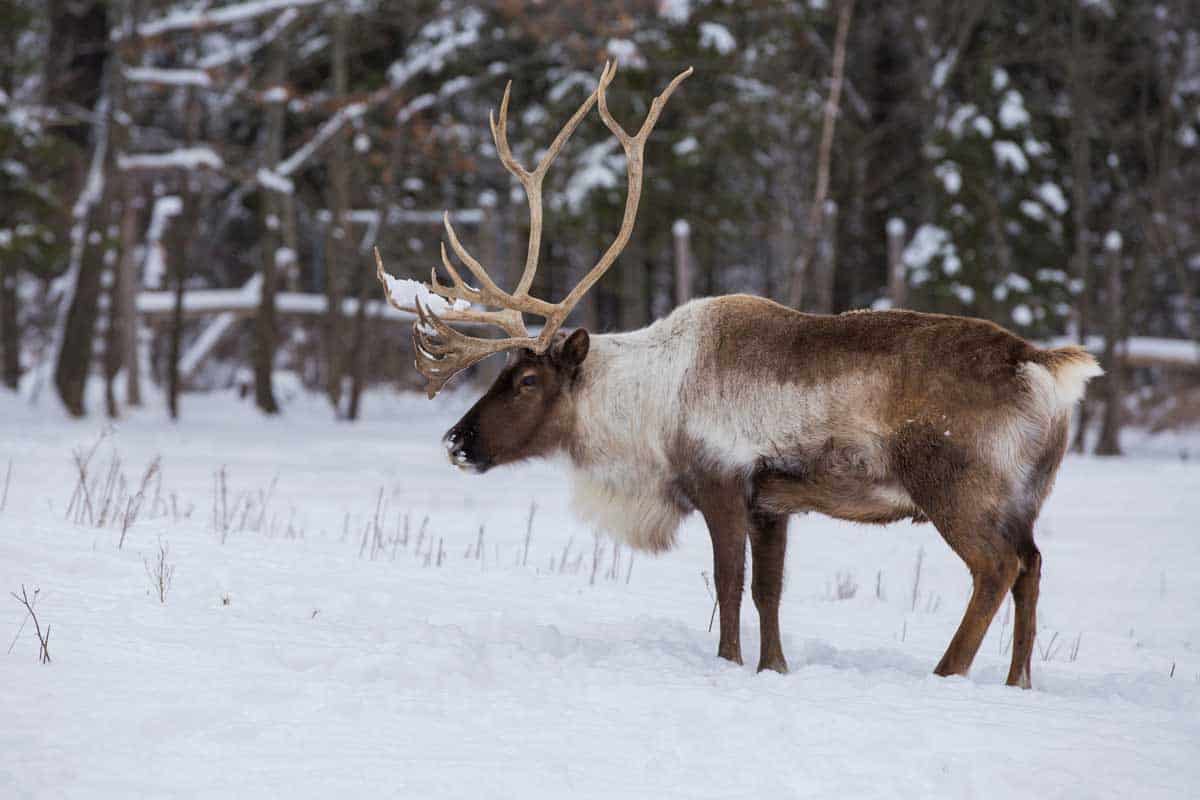We all know caribous as a holiday symbol. But there is a ton of things many people don’t know about these incredible creatures, including their diet, habits, biology, adaptations to the area they inhabit, and so forth.
While this article mostly attempts to answer the question, “What do caribous eat?” we will also look at other aspects of the animals’ lives to help you understand them better. So, stay tuned.
Caribou Habits and Biology
Also known as reindeers, caribous are large mammals belonging to the deer family. They are mostly found in the northern parts of Europe, Asia, North America, and Greenland.
These animals have large, wide hoofs that provide them with stability while walking on snow and soft tundra. The wide feet also help them swim properly.
Caribous have short, firm bodies to conserve heat. Their fur helps keep them warm in the cold and their tails are covered in hair, all to provide insulation.
Although these animals can withstand low temperatures and the rugged terrain of the Arctic region, they are not good at coping with bugs in summer. Caribous are known to run miles and miles just to escape pesky insects.
One of the most interesting features of the caribous is the antlers. Of all members of the dear family, caribous are the only animals where both sexes grow antlers.
Males have larger antlers than females but they usually shed these after mating. Females, on the other hand, keep their antlers until after they have reproduced, and these help protect the young ones and the food sources.
Male caribous fight each other for mates using their antlers. During the breeding period, a male caribou will chase after the female they are interested in thrashing its antlers in bushes. A single caribou can mate with between 5 and 15 females in one breeding season.
Females usually give birth to 1 or 2 calves 7 or 8 months after breeding. A healthy calf will stand on their own 20 to 30 minutes after birth and will be able to travel with the rest of the herd within 24 hours of birth.
Caribous are nomadic creatures; they will constantly move from place to place looking for food. These animals are known to travel hundreds of miles every year.
What Do Caribous Eat in the Wild?
Caribous are herbivores, and as mentioned, they are nomads and must stay on the move to find something to eat. When winter sets in, these animals travel south where they can stay a little warm as they look for food. They will use the bottom of their hoofs to dig for food.
Come summer, caribous will go back north in a large herd and may travel for over 600 miles. They will spend the better part of summer feeding on vegetation that grew in the spring. An adult caribou eats between 10 to 12 pounds of food every day.
Watch this video of caribous searching for food during winter:
What Do Caribous Like to Eat?
Caribous will eat different types of foods depending on the time of the year and what’s available. In the summer, they will feed on:
- Willow leaves
- Flowering tundra plants
- Mushroom
- Sedges
In the winter, caribous will mainly feed on:
- Lichens
- Small shrubs such as blueberry
- Dried sedges
How Does Caribous’ Diet Benefit the Ecosystem?
When caribous forage on plants during summer, their fecal droppings add the much-needed nitrogen to the soil. And as we know, nitrogen is crucial for plant growth. Not only does it help the tundra plants in processing food but also in developing their green color.
Without sufficient nitrogen in the soil, plants will neither grow tall nor produce enough food. They will usually turn yellow and die and caribous and other animals who rely on tundra vegetation will have nothing to eat.
Caribous also help with seed dispersal. Their droppings may sometimes contain sedge seeds or seeds from other vegetation that they eat, giving these plants a chance to scatter and grow in many different areas. This increases their population, providing more food options for caribous and other animals living in the arctic region.
Facts About Caribous
1. Female Caribous Live Longer Than Males
While most male caribous will live for between 7 and 8 years, the females have been found to live for up to 15 years. However, this is the average lifespan. How long a caribou lives will be determined by many other factors including the herd they live in.
If a caribou is in a group that is declining, it will likely have a shorter lifespan than one in a large, healthy herd. Also, there are many caribous that die within the first 12 months of their birth and never get to become adults.
2. Mothers Have an Extremely Strong Bond With Their Calves
After a caribou gives birth, a strong bond develops between them and the young one. They will stay next to each other almost all the time and they can identify each other using smell and the unique sounds that they make.
Such a strong relationship is important between the mother caribou and their young one, as caribou calves can run pretty fast just a few hours after birth. During migration, the calves will walk hand in hand with their mothers and if by any chance they get separated, the mothers will search for many hours to find their calves.
If the calves become permanently separated from their mothers or the mothers die when they are only a few months old, they will likely not survive.
3. Caribous Assess Their Predators Before They Can Run
Sometimes it may look like caribous don’t fear predators or like they are just sitting around waiting to be eaten. But that’s not the case. Caribous will fast examine the type of predator it is and will only run if the animal gets too close to them.
However, there are a number of characteristics that make it seem like these animals don’t display the expected amount of distress when they see a predator. For instance;
When a caribou sees something they are not sure what it is, they will walk toward it to investigate before deciding whether they will stay or run for their life.
Caribous run extremely fast and can run faster than most of their predators over short distances. As such, these animals may appear as if they are not afraid of a creature that is not running toward them and actively chasing them.
Another reason why caribous may seem as if they are ignoring predators is that they don’t want to spend their energy running when they really don’t have to. Caribous are smart and just by looking at the predator, they can tell whether it is a threat and whether they are at a safe distance.
If a predator walks near a herd of caribous without threatening them, the animals will continue to do their business without worrying much about the predator. The only time caribous will run is if the predator starts charging toward them.
4. One Herd Can Have Over 200,000 Caribous
There are currently four major herds of caribou – the Western Arctic Herd, the Porcupine Herd, the Taimyr Peninsula Herd, and the Qamanirjuag Herd. Each of these herds holds more than 200,000 caribous. However, these numbers keep fluctuating due to various factors and sometimes the herds can have less than 200,000 individuals.
5. Caribou’s Meat is Leaner Than Beef
Because caribous are always on the move, most of the food they eat is used to fuel their travel, hence, they do not store much fat in their muscles like cattle do. Their meat is, therefore, leaner and is considered much healthier than beef. It’s quite tasty too.
6. Caribous Will Generally Not Let You Come Close to Them
…unless they are moving in a group. A few weeks after the little ones are born, caribous start to gather in herds ready to start their migration. Before this time, they will move faster and will be warier of their surroundings. It will be very difficult to approach them without scaring them away.
But when they are in groups, caribous are not very alert and you can actually walk toward them and they won’t see you.
7. Caribous Are Fast Runners
Caribous can run at a speed of over 45 mph. During summer, their footpads expand and become soft enough to carry them through the soggy summer tundra. When the temperatures start to dip and winter sets in, the footpads shrink and harden, enabling them to walk and dig into the snow for food.
Summary
Caribous’ diet is determined by the season of the year. In the summer, they will feed on the plants that grew in the spring, and come winter, they will switch to lichens and other vegetation that they can find in the snow-covered habitat. Whenever they can’t find food in their current location, they will move to a different region to look for it.

